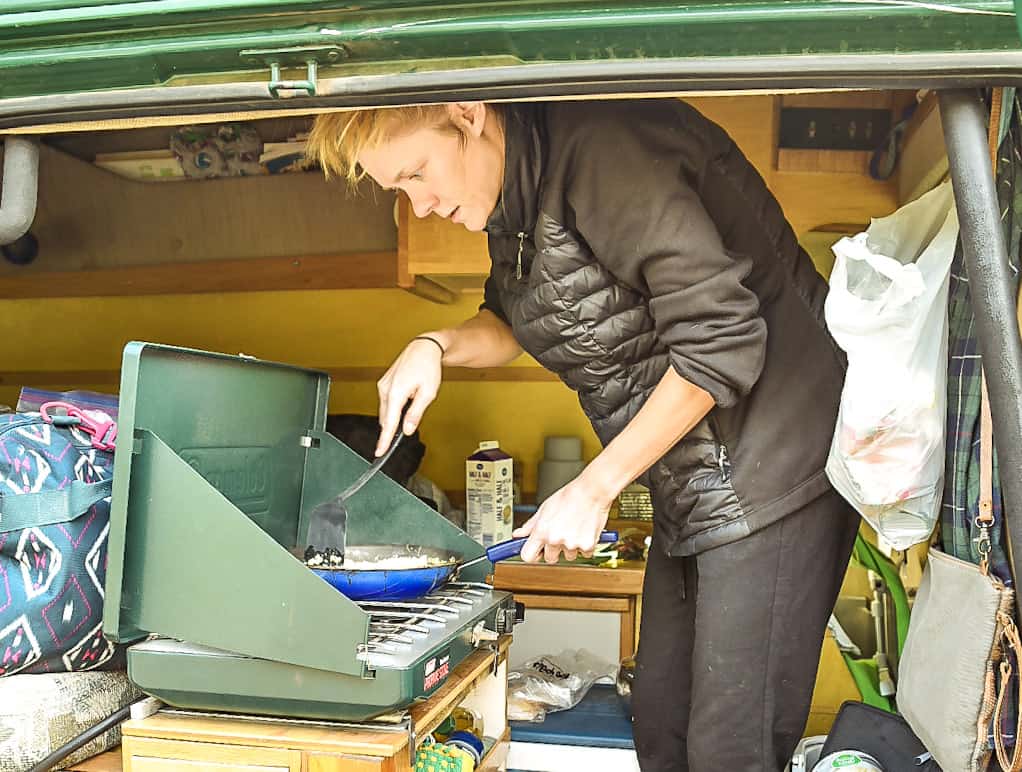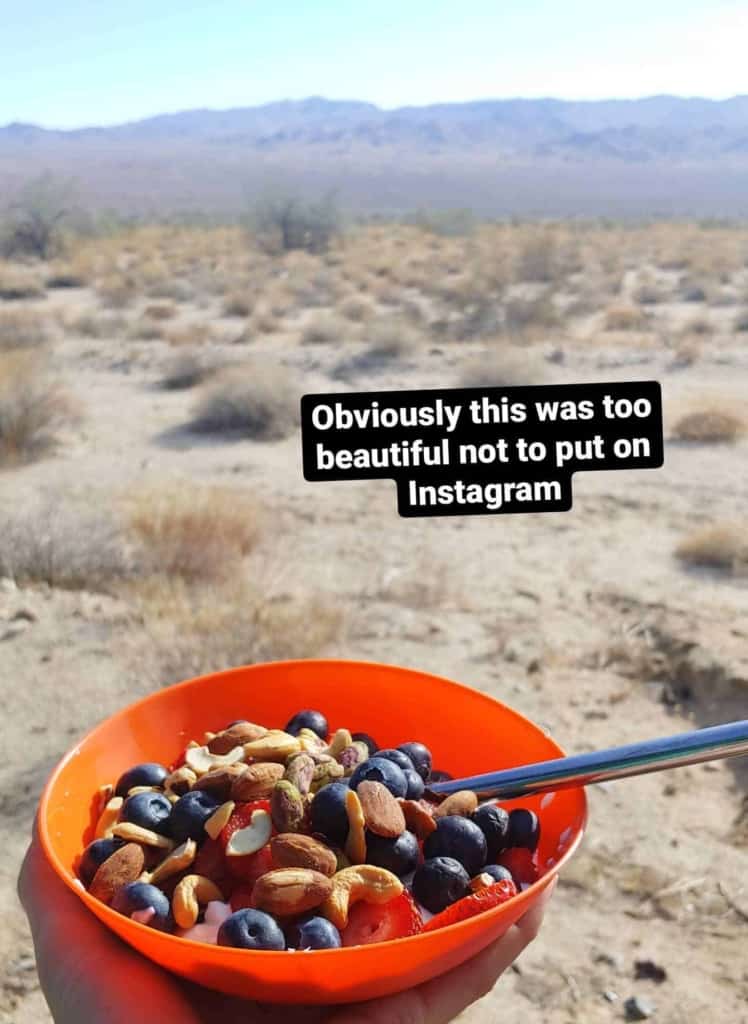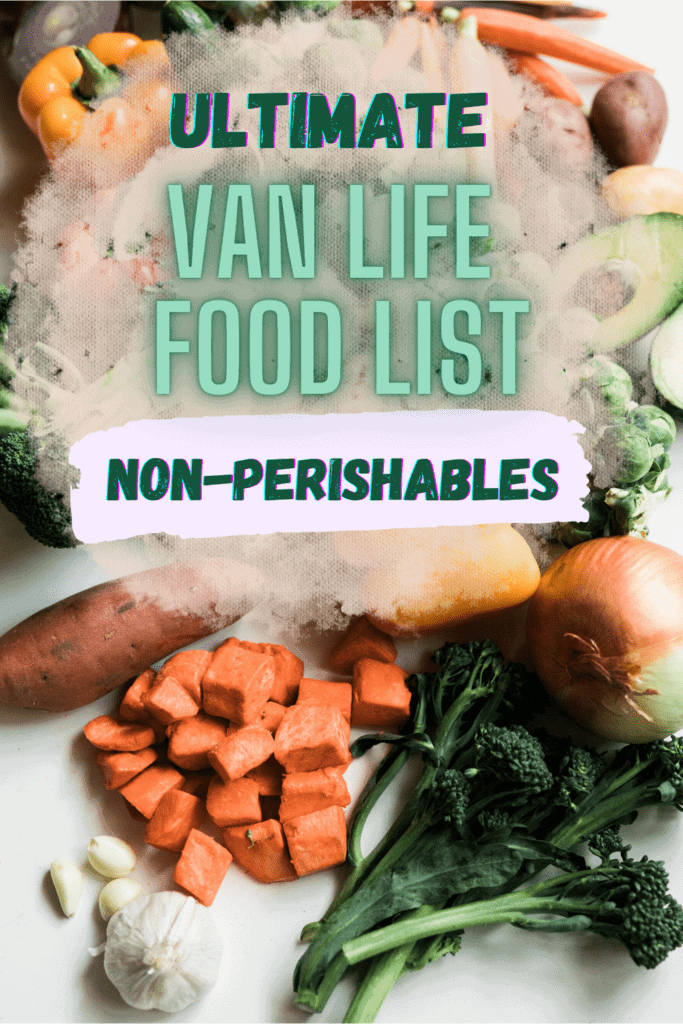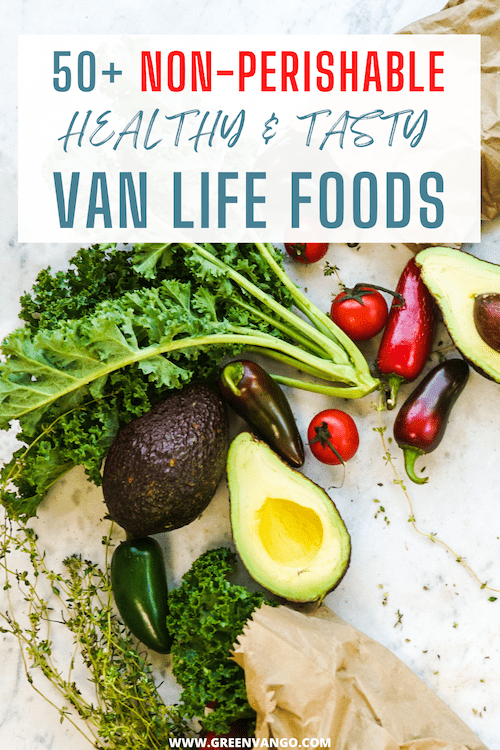After a year of living on the road without a van fridge, I’ve become a lot better at not wasting food and keeping my cooler cold for as long as possible.
You can still eat healthy and keep grocery bills low if you follow some best practices (check out my three favorite van life meals for under twenty bucks).
So, what are some of the best non-perishable foods for van life? And what tricks have I learned for maximizing their shelf life?

1. Vegetables That Don't Need Refrigeration
To know which vegetables don’t require refrigeration, simply walk through a grocery store and look for the ones in the non-refrigeration areas.
But, there are some veggies that can last without refrigeration even if they are refrigerated in a store.
The trick is to store them in a way that minimizes bruising or extreme temperature changes.
Onions. Eat them raw, grill or sautee them.
Tomatoes. Cherry, heirloom, on the vine or roma tomatoes can all be left at room temperature.
Carrots. While you can use baby carrots, they may dry out faster than fulls-size carrots because they’ve already been peeled and moistened.
Potatoes. Potatoes keep for ages–this includes all kinds, such as sweet potato and golden potato.
Avocados. They can bruise easily but don’t need refrigeration. Try wrapping them in a fabric or paper towel to minimize bruising.
Bell peppers. Red, yellow or green bell peppers will all keep for at least 5-7 days without refrigeration.
Broccoli and asparagus can last 2-4 days without refrigeration. I recommend wrapping them in tin foil but leaving the ends open to help prevent bruising but release moisture (so they don’t rot).
Cucumber and zucchini can also last about 2-4 days without refrigeration. I recommend the same process as broccoli and asparagus.
Root vegetables are great because they can easily last a week or more without refrigeration. These include potatoes, sweet potatoes, turnips, kale, beets, radishes and onions.
Canned vegetables are always available and will last just about forever. Personally, the only canned vegetables I like are beets. But if you’re looking to add some health perks to an otherwise bland meal of rice or pasta, throwing in a canned veggie is a great option.
2. Meat & Proteins That Don't Need Refrigeration
I have found that meats are easiest to deal with if they’re pre-cooked, canned or in the form of cold cuts.
Canned chicken. It seems you get what you pay for with this product. Costco has some amazingly moist and delicious canned chicken. Sorry I said moist. But then I bought canned chicken from Smith’s grocery store and it was dry and flavorless.
Cans or packets of tuna. I always have some of the Starkist tuna packets on hand. Canned tuna is cheaper but I can’t finish a whole can in one sitting and don’t want to waste or have smelly tuna cans in my van. Tuna is a power food–low in fat and high in protein.You can buy the flavored tuna packets as well, so they already have seasoning.
Beef jerky. Not everyone is a fan of beef jerky but it’s very low in fat and carbs, and high in protein.
Tofu. Well, sort of – there are some types of tofu that you can buy unrefrigerated. But the catch is that once they’re opened, they need to be refrigerated. So you need to use it all up in one meal! Tofu is a great source of protein.
Nuts. Nuts are rich in protein and complex “healthy” fats. One of the healthiest (and least expensive) is the almond. I typically get mixed nuts though because I love cashews and walnuts. I recommend buying them raw (as opposed to roasted) because they lose a lot of their health benefits once roasted.

3. Dairy (And Dairy Alternatives) That Don't Need Refrigeration
Some hard block cheese don’t need refrigeration. But dairy without a fridge is really tough. Here are the options:
Parmesan or sharp cheddar block cheese. These cheeses are so dehydrated they can last fine without refrigeration.
Powdered milk. Yeah, not my first choice either.
Condensed or evaporated milk. These have a thicker consistency than milk and are sweet, but can be added to dishes for cooking.
Personally, I just buy dairy products when I know I’ll use them all up right away.
4. Fruit That Doesn't Need Refrigeration
Fruit–nature’s dessert! Thankfully there are lots of fruits that don’t need refrigeration.
Apples
Bananas
Peaches
Plums
Oranges
Grapefruit
Grapes (will last a few days)
Blueberries (will last 2-3 days)
Applesauce cups (no sugar added)
Fruit cups (will last but contain lots of sugar)
Dried fruit (long shelf life but contain lots of sugar)
Fruits that come with an outer skin as a protective layer naturally “package” themselves so they don’t need to be refrigerated. But keeping them cool will help increase shelf life.
5. Grains & Starches
Grains are the easiest to store in a van because none of them require refrigeration. The ones that I find the most versatile, healthy and/or tasty are:
Quinoa. Ha! Actually this is technically a seed–but it cooks like a grain and is insanely rich in protein and contains all nine essential amino acids. I like the crunch paired with the grainy texture.
Oats. Traditional (not instant) oats are rich in fiber and protein. Boil them in water for 15 minutes and add anything from fruit, peanut butter, protein powder, honey, sugar, maple syrup, or whatever your heart desires for a tasty and hearty breakfast.
Rice. I prefer jasmine or brown rice because they’re a little richer in nutrients than just white rice–but a great “blank canvas” for meats and veggies.
Pasta. Pasta gets a bad rap for just being a “carb bomb”–but anything in moderation is fine. Especially if you opt for whole wheat or veggie pasta, they add a little more nutrients.
Wraps/bread. The shelf life of these items will reduce without refrigeration, but they’ll still be fine for a week or so. I find if I buy these items from Trader Joe’s or more health-conscious grocery stores, these items go bad quicker because they aren’t loaded with preservatives. But, I’m willing to deal with that if it means not filling my body with preservatives.
Staple Non-Refrigerated Food Items
At any given time, I’ll have these items in my van:
Peanut butter
Raw almonds / mixed nuts
Canned baked beans
Canned chili
Canned soup
Tuna packets
Trail mix
Craisins or raisins
How do I maximize the shelf life of canned goods?
- Avoid extreme temperatures and heat fluctuations
- Rotate canned goods so I use the oldest first and the newest last
- Try to use canned goods within a year of purchasing
Check out my favorite van life storage containers for foods and spices. Eating is too much fun–just because you’re living budget van life fridge-less, doesn’t mean your palette has to suffer!
Save this on Pinterest



6 Comments
Syeda
Excellent tips
Kudos on your travels👍💯
Mubiana
Very interesting but yet humbling life without refrigeration. Great tips!
Shane
I’ve lived without a fridge for 2 years now. One thing I’ve done is get a big cooler and fill the cooler half up with ice and then add rock salt to the ice. It will freeze hard as a block and you can then put meats in a plastic container and put in on too of that ice and they will stay cool and good for about a week like that. Downside cleaning out the cooler good every week. 👍
Layla
Thanks for the tip! My refrigerator went down a week after 4th of July and the prices of them are crazy. So I figure I’d just do without.
Edgie
This is great advice. I’m having to turn off my fridge due to the rise in electric bills (UK). Just can’t afford it. Having bought some veggie products (Quorn sausages) which went green after 3 days, I’m now looking for alternative. I forgot avocado and didn’t know quinoa was a seed. Way to go! Thank you
Jarrod
“Avoid extreme temperatures and heat fluctuations” This made me laugh since it was 100 last week and now its low 30s in the van! 🙂 Thanks for the info and what would your favorite van meal be?